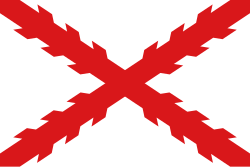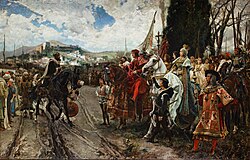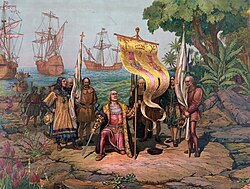Spanish Empire
The Spanish Empire (Spanish: Imperio español), also known as the Hispanic Monarchy (Spanish: Monarquía Hispánica) or the Catholic Monarchy (Spanish: Monarquía Católica)[1][2][3] was one of the largest empires in history and became one of the first global empires in world history.[4]
Spanish Empire Imperio Español | |||||||||
|---|---|---|---|---|---|---|---|---|---|
| 1492–1976 | |||||||||
 | |||||||||
| Capital | Toledo (1492-1561) Madrid (from 1561) | ||||||||
| Common languages | Spanish | ||||||||
| Religion | Roman Catholic | ||||||||
| Government | Monarchy | ||||||||
| Monarch | |||||||||
• 1516-1556 | Charles I | ||||||||
• 1886-1902 | Maria Christina of Austria, Regent during the minority of king Alphonse XIII | ||||||||
| House of Habsburg | |||||||||
| House of Bourbon | |||||||||
| History | |||||||||
• | 1492 | ||||||||
• Conquest of the Aztec Empire | 1519-1521 | ||||||||
• Conquest of the Inca Empire | 1532–1537 | ||||||||
• | 1976 | ||||||||
| Currency | Spanish real, Spanish escudo | ||||||||
| |||||||||
Soon after the Reconquista, Spain became the biggest global empire. It led European exploration of the New World, building the large Viceroyalties in the New World at the time. Spain also created the first intercontinental trade routes across the oceans. The Spanish traded goods across the Atlantic Ocean, between Spain and its viceroyalties in the Americas. They also traded across the Pacific Ocean, between Asian-Pacific countries and Mexico throughout the Spanish treasure fleet and Manila galleons.
Spanish Conquistadores conquered the Aztec, Inca, and Maya Empires together with the help of other native American tribes. They took large territories in North America, South America, Asia, Africa, and Oceania. Spain made these territories into Viceroyalties until the 19th century. Spain, especially the kingdom of Castile, became much more powerful. Also, through royal marriages, the Spanish monarchs created alliances with other European powers. This allowed the Spanish Empire to gain control of many territories in Europe. With all these territories and colonies across the world, the Spanish Empire became the greatest and richest empire in the world.
For a time, the Spanish Empire was a great power in the oceans, with its experienced Navy. Its infantry known as Tercios, recruited from many countries under the rule of the Spanish monarchy, was undefeated for a century a half. Spain enjoyed a cultural golden age in the 16th and 17th centuries. Cervantes, who was the creator of the first modern novel Don Quixote, and many others such as Lope de Vega, Calderón de la Barca, and Francisco de Quevedo were prominent in different branches of Literature, Architecture, Theology, Philosophy and so on.
However, eventually, the French, Portuguese, and British tried to undermine the Spanish monarchy. Starting in the second half of the 17th century, the Spanish Empire began to suffer bankruptcies, and its military began to lose battles. In the 19th century, Spain lost its last major territories overseas in the Spanish-American War.
Colonization
The Spanish Empire was the second global empire in world history[5] and was scattered all over the world. It was constantly fighting with other powers about territories, trade, or religion. For example, the Spanish Empire fought:
- In the Mediterranean against the Ottoman Empire that threatened Europe and supported Barbary piracy in the Mediterranean.
- Against France, due to the Italian Wars and rival attempts to take the prosperous Italian states.
- In the American Revolutionary War
- Against Protestant Leagues in Germany
- Against the Dutch Republic, in the Eighty Years' War
- Against England due to many reasons over the course of centuries. England joined the Protestant Reformation since Henry VIII and helped the Dutch Republic rebels. These efforts culminated in the Spanish Armada. Over the years the British tried to take rich places in the Spanish Americas, succeeding in some such as Jamaica and, during the Seven Years' War, Spanish Florida.
Many of these different powers fought constantly, often at the same time, for long periods. They fought about both political and religious differences, and for ambition as well.
In Europe
The Spanish Empire slowly lost power, as it gradually lost territory to other empires. In 1648, Spain and many other powers signed the Peace of Westphalia, which ended both the Thirty Years' War and the Eighty Years' War. In 1659, the Treaty of the Pyrenees ended fighting between France and Spain. With these treaties, Spain began to lose its status as hegemonic power in Europe.
In 1713, Philip V signed the Peace of Utrecht. In this treaty, Spain gave up its territories in Italy and The Netherlands. Spain was no longer Europe's greatest power. However, it would still have an important role in European politics and a huge empire in America and the Pacific.
Overseas
However, during this time, Spain kept its large overseas empire, and even made it larger. The Spanish Empire fought against Britain, which was trying to take over more of America; France and the United Provinces in the New World. Spain remained a major economic power until it lost its colonies in the Americas through civil wars for some and revolutions for others.
Decolonization
Spain kept control of two colonies in its empire in America: Cuba and Puerto Rico. It also held onto the Philippines and some preserved islands in Oceania, including the Caroline Islands (including the Palau Islands) and the Marianas (including Guam). However, when Spain lost the Spanish-American War of 1898, it lost almost all of these last territories. Spain kept control only of small islands of Oceania (not including Guam). Spain sold these islands to Germany in 1899 .
Spain still kept territories in Africa. Spain controlled Morocco, Western Sahara, and Equatorial Guinea, until decolonization in the 1960s and 1970s. The last colony to gain independence was the Western Sahara, in 1975.
Definition
The Spanish Empire generally means Spain's overseas provinces in the Americas, Africa, the Pacific and Europe. For instance, traditionally, territories such as the Low Countries or Spanish Netherlands were included as they were part of the possessions of the King of Spain, governed by Spanish officials and defended by Spanish troops. Many historians use both "Habsburg" and "Spanish" when they speak of the empire of Charles V or Philip II. However, the Low Countries were effectively part of Spain during that period.

The Portuguese colonial empire joined Spain and was ruled by the same monarch in "personal union", but Portugal remained a separate state. The Portuguese empire continued to be ruled from Lisbon during this period. Therefore, there was a joint Spanish-Portuguese rule for some time. These jointly run empires have sometimes been called the Spanish-Portuguese Empire.

The 1469 marriage of Ferdinand II of Aragon and Isabella I of Castile created a dynastic union of Aragon and Castile. Spain became a modern state in the early modern period with the union of the Catholic Monarchs.
In 1492, Spain finished a 781 years period of Reconquest with the fall of the last Moorish kingdom of Granada. that same year the Catholic monarchs financed Christopher Columbus voyage to reach India by sailing westwards. Columbus instead found America. That was the start of the Spanish colonization of the continent.
By the Treaty of Tordesillas of 1494, the globe was divided into two hemispheres between Spain and Portugal. Therefore, Spain had the right to start colonies in all of the New World from Alaska to Cape Horn (except Brazil), as well as Asia. The Castilian Empire was the result of a period of rapid colonial expansion into the New World, as well as the Philippines and colonies in Africa: Melilla was captured by Castile in 1497 and Oran in 1509.
Results until today
The Spanish language and the Roman Catholic Church were brought to the Americas and to the Spanish East Indies (Federated States of Micronesia, Guam, Marianas, Palau and the Philippines) by the Spanish colonization which began in the 15th century. Together with the Portuguese empire, the Spanish empire laid the foundations of a globalized trade and culture by opening up the great trans-oceanic trade routes. The laws of the Indies regulated social, political and economic life in the Americas over centuries to protect the indigenous native people of the Americas which started a miscegenation process that other "so called" "Empires" never reached. the mix between Spaniards, Native Americans and Black people could be seen nowadays in most of the countries that became part of that Universal Catholic Spanish Monarchy also called Spanish Empire.
The Spanish monarchy or the Spanish Empire never created "Colonies" but Viceroyalties or Overseas provinces.
The Spanish Empire left a huge cultural, urban and architectural legacy in the Western Hemisphere. Hundreds of towns and cities in the Americas were founded during the Spanish rule. The tangible heritage includes universities, forts, cities, cathedrals, schools, hospitals, missions, government buildings and colonial residences, many of which still stand today. A number of present-day roads, canals, ports or bridges sit where Spanish engineers built them centuries ago. The oldest universities in the Americas were founded by Spanish scholars and Catholic missionaries. The Spanish Empire also left a vast cultural and linguistic legacy. With over 470 million native speakers today, Spanish is the second most spoken native language in the world, as result of the introduction of the language of Castile—Castilian, "Castellano" —from Iberia to Spanish America, later expanded by the governments of successor independent republics. Another cultural legacy of the Spanish empire overseas is the Catholic Church, which remains the main religion in the Spanish Americas. The cultural legacy is also present in the music, architecture, cuisine and fashion of much of Spanish America.
The Spanish language (the second most widely spoken language in the world) and the Roman Catholic faith were brought to America, parts of Africa and the Spanish East Indies, by Spanish colonization which began in the 15th century. It also played a crucial part in sustaining the Catholic Church as the leading Christian denomination in Europe when it was under extreme pressure.
The long colonial period in Spanish America resulted in a mixing of some of the peoples. Most Hispanics in the Americas have mixed European and Indigenous ancestry. While some might also have African ancestry.
In concert with the Portuguese Empire, the Spanish Empire laid the foundations of a truly global trade by opening up the great trans-oceanic trade routes. The Spanish Dollar became the world's first global currency.
One of the features of this trade was the exchange of a great array of domesticated plants and animals between the Old World and the New and vice versa. Some that were introduced to America included wheat, barley, apples, cattle, sheep, pigs, horses, donkeys, and many others. The Old World received from America such things as maize, potatoes, chili peppers, tomatoes, tobacco, beans, squash, cacao (chocolate), vanilla, avocados, pineapples, chewing gum, rubber, peanuts, cashews, Brazil nuts, pecans, blueberries, strawberries, quinoa, amaranth, chia, and agave. The result of these exchanges, known generally as the Columbian Exchange, was to significantly improve the agricultural potential of not only in America, but also that of Europe and Asia.
Spanish Empire Media
Reproducción oficial del himno nacional de España
Crowns and Kingdoms of the Catholic Monarchs in Europe (1500)
El gran capitán at the Battle of Cerignola.
The conquest of the Canary Islands (1402–1496)
Monument to Columbus, Statue commemorating New World discoveries. Western façade of monument. Isabella at the center, Columbus on the left, a cross on her right. Plaza de Colón, Madrid (1881–85)
Iberian-born pope Alexander VI promulgated bulls that invested the Spanish monarchs with ecclesiastical power in the newly found lands overseas.
Related pages
References
- ↑ Fernández Álvarez, Manuel (1979). España y los españoles en los tiempos modernos (in español). University of Salamanca. p. 128.
- ↑ Schneider, Reinhold, 'El Rey de Dios', Belacqva (2002)
- ↑ Hugh Thomas, 'World Without End: The Global Empire of Philip II', Penguin; 1st edition (2015)
- ↑ Thomas, Hugh (August 11, 2015). World Without End: Spain, Philip II, and the First Global Empire. Random House. pp. 496 pages. ISBN 978-0812998115.
- ↑ Powell, Philip Wayne (October 16, 2008). Tree of Hate: Propaganda and Prejudices Affecting United States Relations with the Hispanic World. University of New Mexico Press; First Edition, First Printing edition. ISBN 978-0826345769.
- Archer, Christon; Ferris, John R.; et al (2008). World History of Warfare. Lincoln: University of Nebraska Press. ISBN 978-0803219410
- Armstrong, Edward (1902). The emperor Charles V. New York: The Macmillan Company. ASIN B012DESOAI
- Black, Jeremy (1996). The Cambridge illustrated atlas of warfare: Renaissance to revolution. Cambridge: Cambridge University Press. ISBN 0-521-47033-1
- Braudel, Fernand (1972). The Mediterranean and the Mediterranean World in the Age of Philip II, Vol. I. Translated by Siân Reynolds. New York: Harper & Row. ISBN 978-0060104528
- Braudel, Fernand (1979). The Perspective of the World: Civilization and Capitalization 15th–18th Century, Vol. 3. Translated by Siân Reynolds. University of California Press. ISBN 978-0520081161
- Brown, J. and Elliott, J. H. (1980). A palace for a king. The Buen Retiro and the Court of Philip IV. New Haven: Yale University Press. ISBN 978-0300025071.
- Brown, Jonathan (1998). Painting in Spain : 1500–1700. New Haven: Yale University Press. ISBN 0-300-06472-1
- Dominguez Ortiz, Antonio (1971). The golden age of Spain, 1516-1659. Oxford: Oxford University Press. ISBN 0-297-00405-0
- Edwards, John (2000). The Spain of the Catholic Monarchs, 1474-1520. New York: Blackwell. ISBN 0-631-16165-1
- Harman, Alec (1969). Late Renaissance and Baroque music. New York: Schocken Books. ISBN 978-0805202625
- Kamen, Henry (1998). Philip of Spain. New Haven and London: Yale University Press. ISBN 0-300-07800-5
- Kamen, Henry (2003). Empire: How Spain Became a World Power, 1492-1763. New York: HarperCollins. ISBN 0-06-093264-3
- Kamen, Henry (2005). Spain 1469-1714. A Society of Conflict (3rd ed.) London and New York: Pearson Longman. ISBN 0-582-78464-6
- Parker, Geoffrey (1997). The Thirty Years' War (2nd ed.). New York: Routledge. ISBN 0-415-12883-8
- Parker, Geoffrey (1972). The Army of flanders and the Spanish road, 1567-1659; the logistics of Spanish victory and defeat in the Low Countries' Wars.. Cambridge: Cambridge University Press. ISBN 0-521-08462-8
- Parker, Geoffrey (1977). The Dutch revolt. Cambridge: Cambridge University Press. ISBN 0-8014-1136-X
- Parker, Geoffrey (1978). Philip II. Boston: Little, Brown. ISBN 0-316-69080-5
- Parker, Geoffrey (1997). The general crisis of the seventeenth century. New York: Routledge. ISBN 0-415-16518-0
- Shaw, D.L. (ed.) (1983). Historia de la literatura española 5: El siglo XIX. In Spanish. Barcelona: Editorial Ariel. ISBN 978-8434483569
- Stradling, R. A. (1988). Philip IV and the government of Spain. Cambridge: Cambridge University Press. ISBN 0-521-32333-9
- Thomas, Hugh (1997). The Slave Trade; The History of the Atlantic Slave Trade 1440-1870. London: Papermac. ISBN 0-333-73147-6
- Wright, Esmond, ed. (1984). History of the World, Part II: The last five hundred years (3rd ed.). New York: Hamlyn Publishing. ISBN 0-517-43644-2
Other websites
- Library of Iberian Resources Online, Stanley G Payne A History of Spain and Portugal vol 1 Ch 13 "The Spanish Empire"
- The Mestizo-Mexicano-Indian History in the USA Archived 1996-12-26 at Archive.today
- Documentary Film, Villa de Albuquerque Archived 2007-12-23 at the Wayback Machine
- The last Spanish colonies (in Spanish)Archived 2009-10-26 at the Wayback Machine










